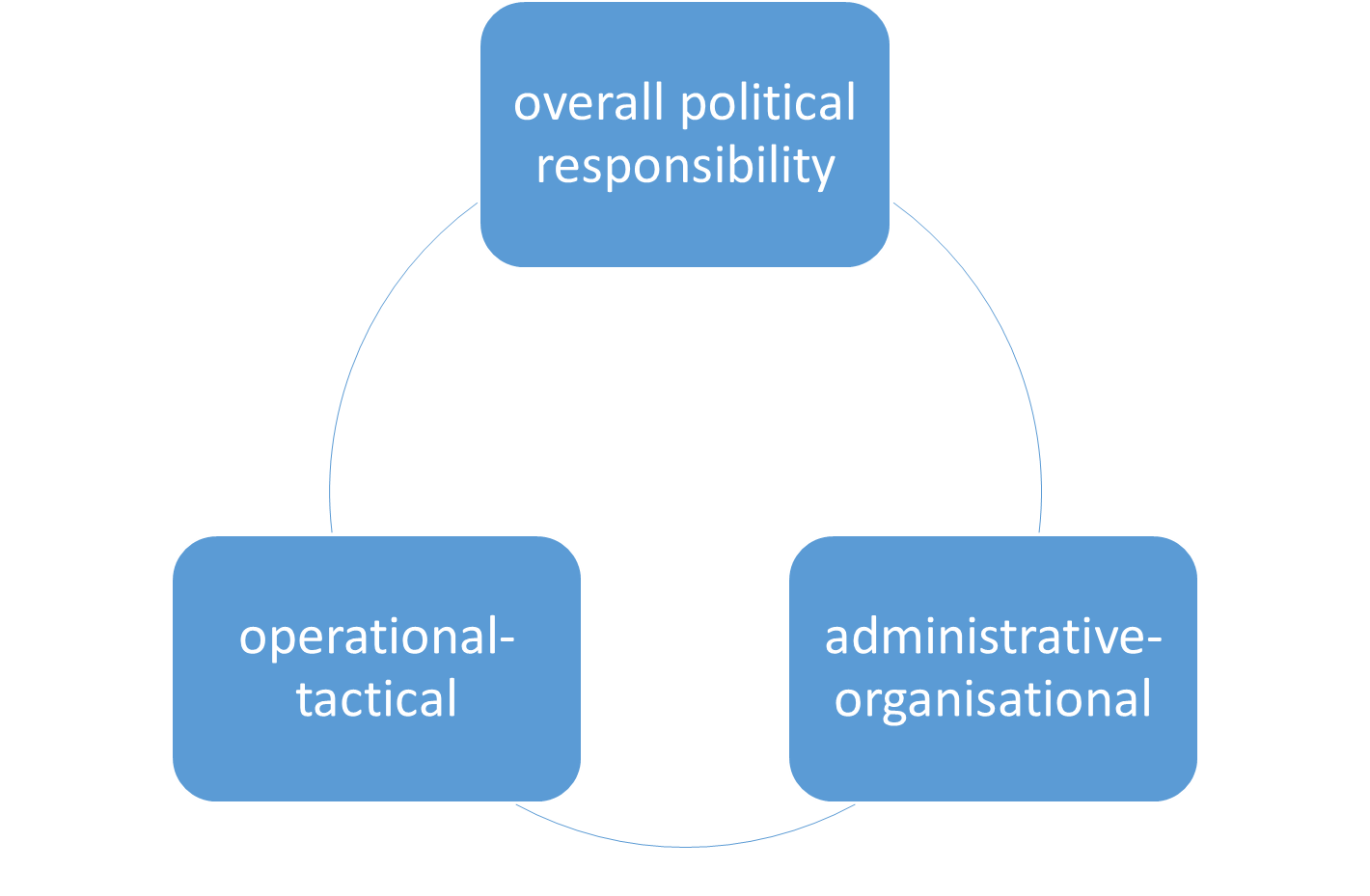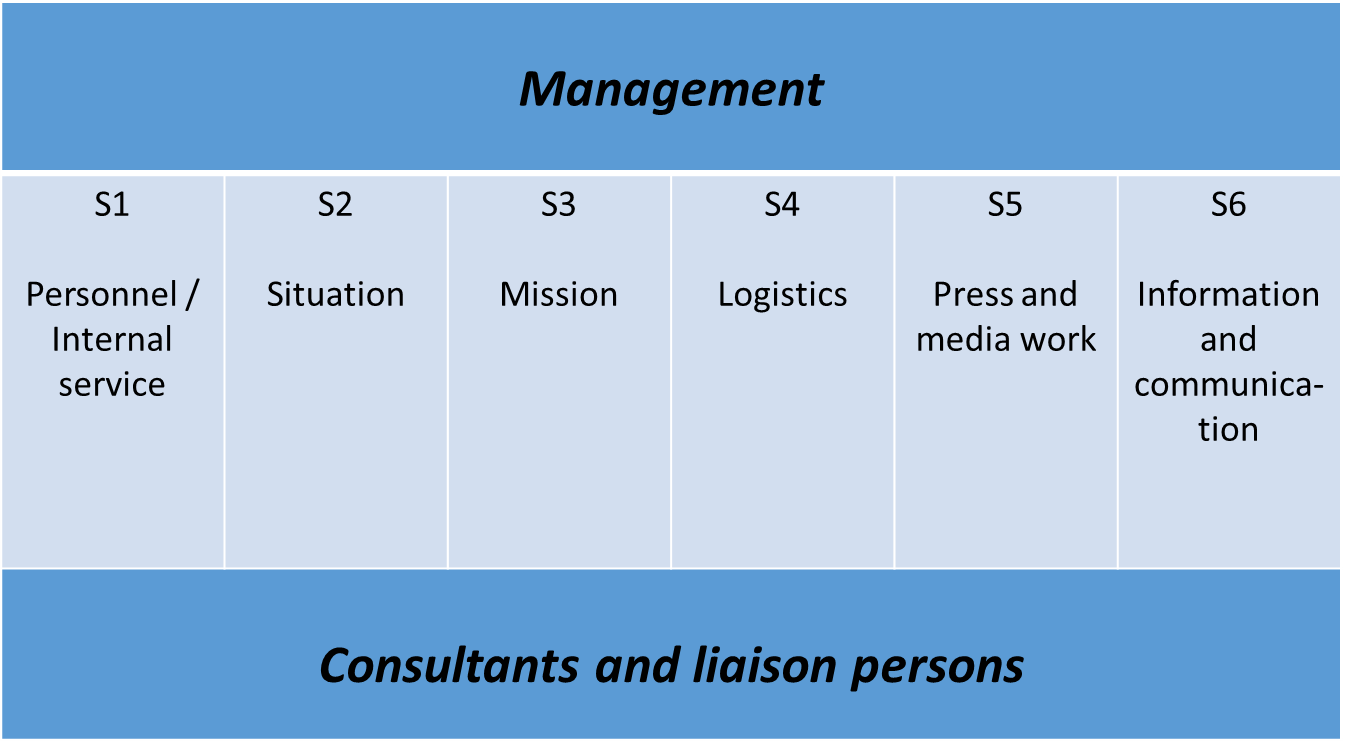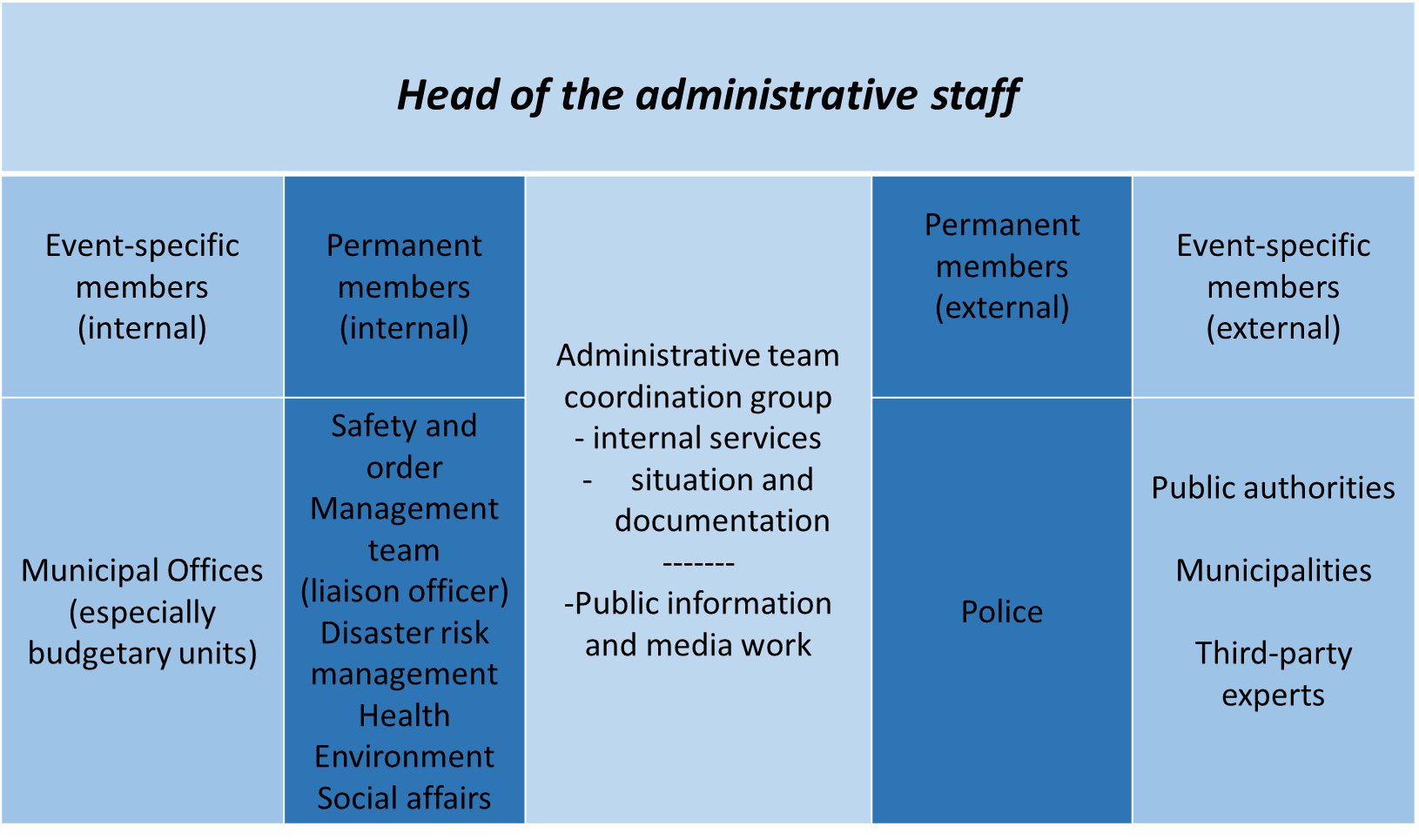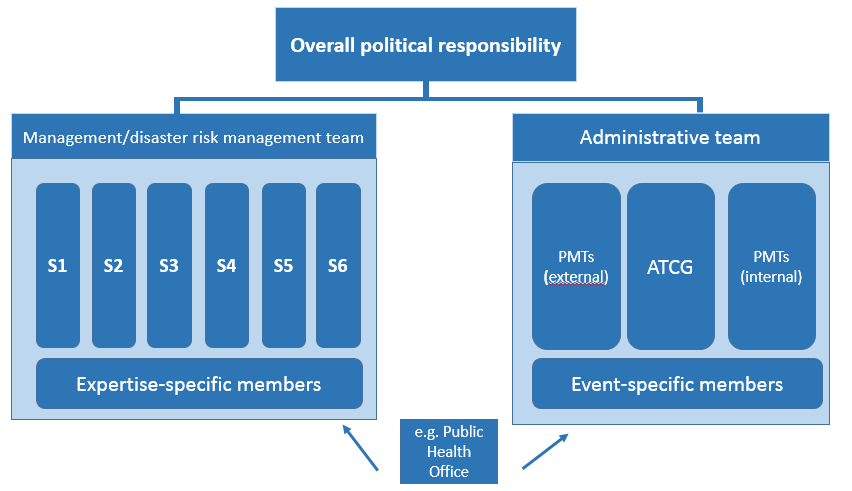Importance of a work/crisis team
Generally speaking, the established administrative structures of the public health offices, as well as other public health institutions, lack the preparedness that would enable them to respond effectively e.g. to the challenges of a biological emergency or crisis swiftly, without errors and under a uniform management structure. To meet these requirements, when such incidents occur one obvious option for public health authorities is to operate in team mode. Operating within the structures of a work/crisis team is similar to working in projects. When working under a uniform management structure it is necessary to monitor the performance of tasks, coordinate deadlines and document decisions.
As well as the measures to cope with the urgent tasks (in a crisis) that result e.g. from a biological hazard, it must also be ensured that all other vital sovereign functions (outbreak management, autopsies, reporting etc.) can be guaranteed as well, possibly with fewer human and other resources. It is then essential to prioritise tasks.
When the public health office and other public health institutions work together in teams, it is advisable to take account of the emergency preparedness and disaster risk management structures that already exist in the administrative district, city or region. Here it is necessary to clarify whether in a health-related situation the health sector structures should assume a lead role. Germany's various regions have different models. In some cases the health sector takes the lead, while in others joint teams are formed that include the health and interior/disaster risk management sectors.
Organisation & management of teams
Responding to emergencies and disasters involves three relevant components of management:
-
the overall political responsibility component
-
the operational-tactical component and
-
the administrative-organisational component.
In Germany the structures are largely the same at the levels of administrative districts and independent cities.

The overall political responsibility component
Particularly in large-scale and long-lasting emergencies or disasters, the individual with overall political responsibility (e.g. mayor, district chief executive or minister) will assume leadership. This is also the case with biological emergencies. Within this framework, the individual with overall political responsibility initiates and holds responsibility for both operational (operational-tactical) and administrative (administrative-organisational) measures. Depending on the regulations in force in the federal state, either two separate teams (one management/disaster risk management team and one administrative team), or a single overall team that integrates the two areas, will be tasked to carry out the measures.
The operational-tactical component
At the operational-tactical level, in emergencies below the threshold of a disaster (large-scale emergency) the 'management team' is the structure used. In the case of larger emergencies above the disaster threshold the 'disaster risk management team' is mobilised. The two teams usually comprise the same members. A management team may have fewer team members, however. Team structures are enlarged in proportion to the scale of an emergency incident.
Official regulation DV 100 'Leadership and command in emergency operations'
In Germany, all disaster risk management organisations (fire service, emergency services, police/regulatory authorities and relief organisations) also operate in team mode in emergency operations, each according to the same type of official regulation (e.g. the fire service regulation 'Leadership and command in emergency operations' (FwDV 100). To enable the health authorities to find their way round this structure it is important to integrate it into the emergency and disaster response system early on.
In Germany, at the level of cities and administrative districts the respective official regulation is the management instrument for all emergency and disaster response agencies. The official regulation integrates all representatives of the key areas of emergency and disaster response and health care into a single management framework with equal responsibility.
A management or disaster risk management team takes care of all the operational-tactical measures that arise, e.g. formation of sections, provision of personnel and reserves, or the establishment and operation of a communication structure.

In general, the following staff functions (S) should be established in both teams:
-
S 1 (Personnel) steers all operative personnel.
-
S 2 (Situation) collects all facts needed to assess the situation. Staff function S2 also includes the mission diary and review functions.
-
S 3 (Mission) coordinates and monitors all operational tasks. It is also responsible for task control.
-
S 4 (Logistics) steers all logistics activities and the required materials.
-
S 5 (Press and media work) coordinated the press and media work with all stakeholders.
-
S 6 (IT and communications) provides IT services and all communications technology.
When incidents (e.g. escape of a chemical substance) occur, the public health office can provide expert advisors and liaison persons for the management/disaster risk management team.
The aforementioned staff functions are described in more detail in the section 'Tasks of the staff functions'.
The administrative-organisational component
Depending on the regional provisions, as well as a management/disaster risk management team there may also be an administrative team that functions either as a stand-alone unit or in conjunction with the management/disaster risk management team. When the two teams operate together they form a single unit. While the management/disaster risk management team covers the operational-tactical component, the administrative team deals with the administrative-organisational side of disaster risk management. Under time-critical conditions and taking all aspects into account, the administrative team is there to take decisions for which the management/disaster risk management team is not responsible due to legal requirements, financial responsibilities and political frameworks. These include e.g. decisions on closing public institutions and facilities.
To enable a supra-regional, standard organisational structure a document (German only) has been published for Germany's regional states entitled Forming teams – the administrative-organisational component. This advice it contains applies to the work of teams both in large-scale emergencies and in case of disaster. Some of Germany's regional states are already using this component for incidents below the threshold of a large-scale emergency.
According to this advice the administrative team should include representatives of all departments necessary/responsible for managing the emergency in the regional administration, other public authorities and third parties with relevant expertise. As well as permanent members of the team, which also include representatives of the public health office/public health authority as expert advisors, the team will also include incident-specific members. These might also be non-governmental actors (e.g. electricity providers in the event of a power failure). The graphic below – 'Structure of an administrative team' – provides an overview of the composition of an administrative team:

The 'team leader' is responsible for leading and coordinating the administrative team. This individual takes decisions on measures to be introduced, defines objectives, and decides on the appointment of further situation-specific members. If political responsibility does not rest with the administrative team leader, the team leader decides which measures will be determined within the team and which ones by the body with overall political responsibility.
The administrative team coordination group (ATCG) comprises the sections internal services and situation and documentation. The internal services section alerts team members and when necessary updates the team's official regulations, as well as the alert and contact data lists. It also ensures that the team is operational, i.e. availability of resources, reordering of materials, organisation of rooms and meetings. The ATCG section situation and documentation is responsible for requesting, collating, evaluating and documenting information and reports on the situation and reports. It also keeps the mission diary, and is responsible for describing the situation and forecasting future development.
The public information and media work (PIMW) function coordinates, supports and informs the press and other media, e.g. by preparing press briefings, evaluating press releases or setting up a public hotline.
Permanent members of the team (PMTs) assess the incident from their own expert perspective, describe problems and hazards from their perspective, and identify options and proposals for expedient measures. The PMTs are representatives of necessary departments, public authorities or third parties who possess decision-making authority. The areas usually represented are public safety and order, disaster risk management, health, environment, the police force and social affairs. Depending on the situation, further departments may be involved such as construction and housing supervision (e.g. in case of fires), the education authority etc. A member will also be appointed to liaise with the management team.
As with the PMTs, event-specific members of the team (ESMTs) also bring their specific expertise to bear in assessing and managing the situation. They are selected according to the situation, and comprise representatives of departments of the sub-regional authority's own administration, other public authorities, municipalities or third parties with relevant expertise, who are authorised to take decisions. In Germany the latter include for instance the fire department; aid organisations; the Federal Agency for Technical Relief (THW), the Bundeswehr; energy utility companies and transport companies. The ESMTs can to some extent perform their task within the scope of their normal work, and need not be permanently present on the administrative team.
Cooperation between the teams
The graphic below provides an overview of how the teams work together when crises occur:

The crisis team in the public health office
In the event of a crisis, the public health office's work/crisis team is basically a supplementary organisational structure within the office which is there to support the director, who will usually represent the public health office on the management or disaster risk management team.
The public health office team itself usually does not perform a management role. Instead it coordinates and designs the measures as instructed by the director of the public health office. In case of limited biological emergencies, however, it can and should also act autonomously. When more major hazards arise, on the other hand, it is a supportive element that reports to the director on the management/disaster risk management team.
Public health offices perform both administrative-organisational tasks, such as coordination and decision-making on specialist tasks within their own sphere of responsibility, as well as operational-tactical tasks such as the formation of focal areas of operation, the deployment of personnel and the management of logistics.
Depending on circumstances with regard to human resources, the structure of the team in public health officers should be based on the German fire service regulation FwDV 100. If the hazards and the tasks faced by the team so require, further in-house personnel can be provided to support the team, or if necessary additional personnel can be brought in from other departments. Where expedient for the performance of tasks, team functions should be amalgamated.
For the crisis team to become operational, a certain basic infrastructure first has to be created. The crisis team requires a suitable room with appropriate facilities, including information and communication technology. Several things should always be available, while others can be provided as the occasion demands.
The checklist for ‘Infrastructure and equipment in a crisis team' provides suggestions that you can use when setting up a crisis team.
Crisis management at the level of the supreme regional authorities
Germany's federal state ministries and their subordinate general and specific regional authorities are each responsible for preventing and responding to crises within the scope of their respective remits. When a national response is required in case of looming biological emergencies, when damage has occurred or in case of disasters, the teams of these public health authorities may be called upon.
In some cases these teams assume a lead role based on the 'lead ministry principle', while in other cases joint teams are formed by the ministries of health and the interior. In case of health-related emergencies, the federal state ministries of health can usually propose calling up the team of the regional government. On this team the ministries concerned then work together within the scope of their respective remits and deal with the tasks on the basis of lead ministerial responsibility.
Modus operandi in the team
The team operates on an objectives-oriented basis, in closed iterative conceptual planning and implementation loops. The iterative approach ensures the necessary assessment of the situation and adoption of resolutions.

Functions and tasks in the crisis team
The staff functions and tasks in the crisis team are shown in the following table. They are based on the example of fire service regulation FwDV 100:
|
Function |
Tasks |
|---|---|
|
S 1 (Personnel) |
|
|
S 2 (Situation) |
Ensure information flows
|
|
S 3 (Mission) |
|
|
S 4 (Logistics) |
|
|
S 5 (Press and media work) |
Inform the press and the media
Support the press and the media
|
|
S 6 (IT and communications) |
Plan the use of IT and communications, design a communications strategy, ensure its operationalisation
Equip incident management with office communications |